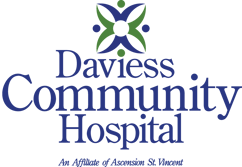How to Read Nutrition Labels: A Guide to Smarter Food Choices
- Category: CORE, DCH, Foundation, Glory, Sleep Lab, Obstetrics & Maternity Services, Acute Care Unit
- Posted On:

When it comes to healthy eating, understanding nutrition labels is one of the most powerful tools you can use to make informed food choices. Yet, many consumers struggle to interpret food labels correctly—often misled by marketing buzzwords or focusing on the wrong information.
Paige Schaefer, MS, RDN, LD, a Clinical Registered Dietitian at Daviess Community Hospital (DCH), explains how to navigate nutrition labels, identify key nutrients, and avoid misleading food claims to support better health.
Why Nutrition Labels Matter
“Nutrition labels help people take control of their health by showing exactly what’s in their food,” said Schaefer. “They’re especially important for managing medical conditions, maintaining a healthy weight, and avoiding misleading marketing claims.”
Key reasons to check nutrition labels include:
✔ Managing medical conditions – Tracking sodium, sugar, and fiber intake is crucial for individuals with high blood pressure, diabetes, or heart disease.
✔ Supporting weight management – Monitoring calorie counts and portion sizes helps maintain a healthy weight.
✔ Guiding healthier choices – Identifying high-nutrient foods leads to better overall wellness.
✔ Preventing misleading claims – Front-of-package marketing can be deceptive, but the nutrition label provides the real facts.
Breaking Down a Nutrition Label
“The first thing I tell people is that what you focus on depends on your health goals,” Schaefer explained. However, some key sections of every nutrition label provide essential insight:
1. Serving Size & Servings Per Container
Determines how much you’re actually consuming—many packaged foods contain multiple servings per container.
2. Calories
Helps with weight control and energy balance—but also consider nutrient density, not just calories alone.
3. Nutrients to Limit
Watch for saturated fat, trans fat, added sugars, and sodium, which can contribute to heart disease, diabetes, and other health concerns.
4. Beneficial Nutrients
Prioritize fiber, protein, vitamins, and minerals like calcium and iron, which support overall health and wellness.
How to Identify High or Low Nutrients
One common mistake is assuming a product is healthy just because it looks good on the surface. Schaefer recommends using % Daily Value (%DV) as a quick reference:
- 5% DV or less = Low in that nutrient
- 20% DV or more = High in that nutrient
“For example, if a food has 25% DV of sodium, it’s considered high in sodium and might not be the best option for someone with high blood pressure,” Schaefer said.
Avoiding Misleading Food Labels
Many food packages use marketing buzzwords to make products seem healthier than they really are. Schaefer advises looking past the front of the package and reading the ingredients list and nutrition facts to get the full picture.
🚫 Common misleading claims:
- “Sugar-free” doesn’t mean calorie-free – It may still contain sugar alcohols.
- “Low-fat” often means high in sugar – Manufacturers add sugar to improve taste.
- “Organic” refers to farming practices, not nutrition quality – Organic products can still be high in sugar or fat.
Spotting Hidden Sugars & Unhealthy Fats
Some ingredients may not be immediately recognizable as unhealthy. Schaefer recommends looking for alternative names that signal added sugars and trans fats:
Hidden Sugars:
✔ High-fructose corn syrup
✔ Evaporated cane juice
✔ Dextrose, maltose, honey, fruit juice concentrate
Unhealthy Fats:
✔ Partially hydrogenated oils (even if the label claims "0g trans fat"—legally allowed if under 0.5g per serving)
Making Smarter Nutrition Choices
Understanding nutrition labels can empower you to make healthier decisions, whether you're shopping for groceries, dining out, or managing a medical condition. By focusing on key nutrients, avoiding marketing gimmicks, and making small, consistent changes, you can take control of your diet and improve long-term health.
More Nutrition Tips!
This is part of a series of expert articles from DCH’s Registered Dietitian, Paige Schaefer, MS, RDN, LD, during National Nutrition Month. Other topics will include:
For more expert nutrition guidance, visit Daviess Community Hospital’s Diabetes & Nutrition Services or call (812) 254-2760.



